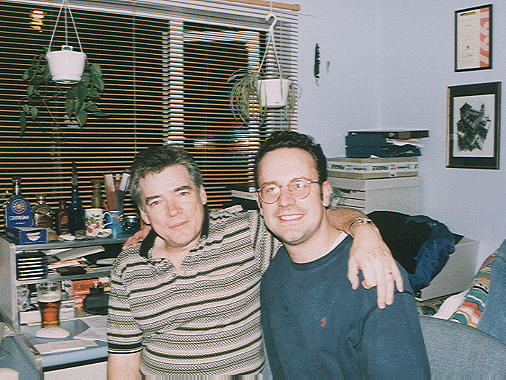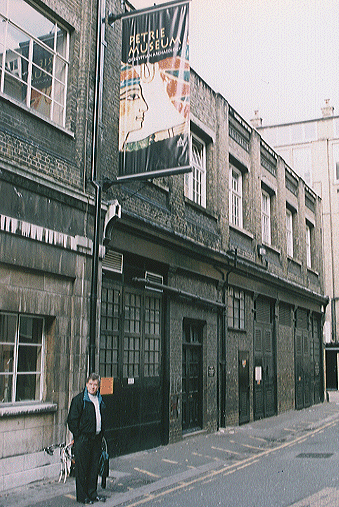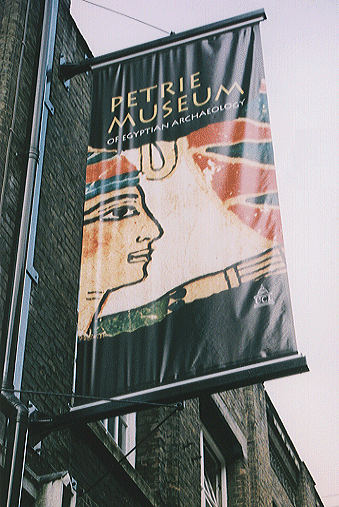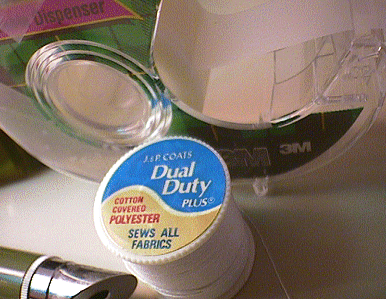Petrie's Infamous Core #7 |
|||
| Chris Dunn 12/9/99 Part One
On November 10, 1999 I flew out of Indianapolis heading for England. Nick Annies had arranged with the Petrie Museum for the inspection of the core while the museum was closed for academic research. On November 15, 1999 Nick Annies and I examined core #7 in the Petrie Museum.
Chris and Nick taken at Nick & Angie's home near Cambridge UK, November 1999 after the inspection of the core (note the celebratory pint of Boddingtons on the left, we had a wonderful day!) I would like to thank Nick and Angie Annies for the wonderful week I spent in their home. I wish my wife Jeanne had been with me to enjoy the hospitality and peace I found there. Before going to London, I had a long conversation with Roger Hopkins, the stone mason who appeared with Mark Lehner on 'This Old Pyramid' and 'Obelisk.' He told me that another Obelisk documentary was produced this year in which Dennis Stocks, a master stone mason, demonstrates core drilling in granite using a copper tube, sand, and manpower - a method that is accepted by Egyptologists as the true method the ancient Egyptians used. Though Roger was initially supportive of my ultrasonic drilling theory, he tempered his original enthusiasm by stating that, while he and Stocks disagreed as to the methods of drilling the rock, he was convinced that it could be done using primitive methods. Other characteristics of Egyptian granite artifacts that we discussed I will address later. Roger told me that the film is in the can, but I couldn't get any details of what kind of core was produced, except that it is similar to Petrie's core. A recent posting to the Atlantis Rising forum on Gizapower by Mikey Brass states that Stocks had produced such a core, but I am still waiting for details about what kind of grooves were produced in it using his methods. With Hopkins joining Reid and Brownlee in their assertion that core #7 was conventionally produced, I went to London to inspect it with the hope that Petrie was correct in his description. At the same time, I recognized that I didn't have any support from some of the more visible members of the disciplines or trades that we would normally call upon to perform the kind of work that actually produced this core! Nick and I took the train to King's Cross on Monday, November 15, 1999. (I remember when I was young how everybody criticized British Rail, but today, the trains were right on time and I marveled at how much traveling in England had changed since then.) A short walk to the University College London found us at 10:30 A.M. standing on the bottom step of the Petrie Museum looking up at a gregarious doorman who pointed us in the direction of a cafeteria advising us to get a cup of tea until the museum was open. Not only a cup-a-tea did we find there, but a wonderful full English breakfast!
Chris on the steps of the Museum
The Petrie Museum at The University College London Then it came time to inspect the infamous core #7. Although I had talked and written about this core for over 15 years, this was not a reverent visit to a holy relic that one might expect. I was not especially breathless with excitement to take the artifact into my latex-gloved hands. Nor was I impressed with its size or character. To tell the truth I was profoundly unmoved and disappointed. With the old Peggy Lee song "Is That All There Is?" bouncing around in my head, I peered at this insignificant looking piece of rock which had fueled such a heated debate on the Internet and in living rooms and pubs across the globe. I was thinking to myself as I looked at the rough grooves on its surface, "How do I make sense of this?" And, "What was Petrie thinking about? Is Mikey Brass pissed at me because he risked his reputation presenting my theory to the Cape Town Egyptological Society?" I looked up at Nick Annies standing over me. He had a look on his face that reminded me of my mother, within whose face I sought comfort when, at the age of 8, I was lying on the operating table having a wart burned out of my palm by a long hot needle. Not a word passed between us as I formulated in my mind my ultimate confession to the world. I had made a huge mistake in trusting Petrie's writings! The core appeared to be exactly as Reid and Brownlee described it! The grooves did not appear to have any remote resemblance to what Petrie described. With the truth resting where a wart once grew, I was frozen in time. I looked at my satchel wondering why I had invested in the tools I had brought. But what the hell, why not take some measurements while I am here. With resignation I proceeded to place the contents of my bag onto the table.
Some of the "hi-tech" tools Chris used
|
|||
| Chris Dunn Ian Lawton Chris Dunn Ian Lawton Chris Dunn Ian Lawton By email to Chris Dunn 12/6/99 Chris Dunn Visit to Petrie Museum Part One - Posted 12/12/1999 Chris Dunn Visit to Petrie Museum Part Two - Posted 12/12/1999 Chris Dunn Visit to Petrie Museum Part Three - Posted 12/12/1999 |
|||
Text and Photographs ©
Copyright 1999 Christopher Dunn With Kind Thanks to the Petrie Museum of Egyptian Archaeology, London. |
|||



